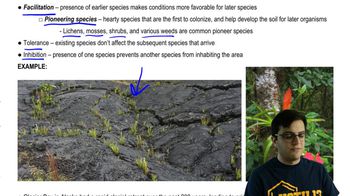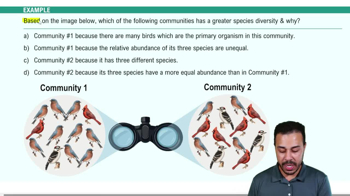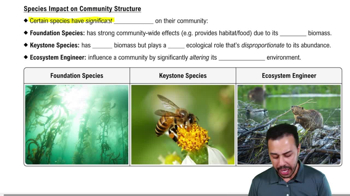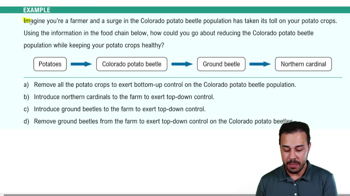Table of contents
- 1. Introduction to Biology2h 42m
- 2. Chemistry3h 40m
- 3. Water1h 26m
- 4. Biomolecules2h 23m
- 5. Cell Components2h 26m
- 6. The Membrane2h 31m
- 7. Energy and Metabolism2h 0m
- 8. Respiration2h 40m
- 9. Photosynthesis2h 49m
- 10. Cell Signaling59m
- 11. Cell Division2h 47m
- 12. Meiosis2h 0m
- 13. Mendelian Genetics4h 44m
- Introduction to Mendel's Experiments7m
- Genotype vs. Phenotype17m
- Punnett Squares13m
- Mendel's Experiments26m
- Mendel's Laws18m
- Monohybrid Crosses19m
- Test Crosses14m
- Dihybrid Crosses20m
- Punnett Square Probability26m
- Incomplete Dominance vs. Codominance20m
- Epistasis7m
- Non-Mendelian Genetics12m
- Pedigrees6m
- Autosomal Inheritance21m
- Sex-Linked Inheritance43m
- X-Inactivation9m
- 14. DNA Synthesis2h 27m
- 15. Gene Expression3h 20m
- 16. Regulation of Expression3h 31m
- Introduction to Regulation of Gene Expression13m
- Prokaryotic Gene Regulation via Operons27m
- The Lac Operon21m
- Glucose's Impact on Lac Operon25m
- The Trp Operon20m
- Review of the Lac Operon & Trp Operon11m
- Introduction to Eukaryotic Gene Regulation9m
- Eukaryotic Chromatin Modifications16m
- Eukaryotic Transcriptional Control22m
- Eukaryotic Post-Transcriptional Regulation28m
- Eukaryotic Post-Translational Regulation13m
- 17. Viruses37m
- 18. Biotechnology2h 58m
- 19. Genomics17m
- 20. Development1h 5m
- 21. Evolution3h 1m
- 22. Evolution of Populations3h 52m
- 23. Speciation1h 37m
- 24. History of Life on Earth2h 6m
- 25. Phylogeny2h 31m
- 26. Prokaryotes4h 59m
- 27. Protists1h 12m
- 28. Plants1h 22m
- 29. Fungi36m
- 30. Overview of Animals34m
- 31. Invertebrates1h 2m
- 32. Vertebrates50m
- 33. Plant Anatomy1h 3m
- 34. Vascular Plant Transport1h 2m
- 35. Soil37m
- 36. Plant Reproduction47m
- 37. Plant Sensation and Response1h 9m
- 38. Animal Form and Function1h 19m
- 39. Digestive System1h 10m
- 40. Circulatory System1h 57m
- 41. Immune System1h 12m
- 42. Osmoregulation and Excretion50m
- 43. Endocrine System1h 4m
- 44. Animal Reproduction1h 2m
- 45. Nervous System1h 55m
- 46. Sensory Systems46m
- 47. Muscle Systems23m
- 48. Ecology3h 11m
- Introduction to Ecology20m
- Biogeography14m
- Earth's Climate Patterns50m
- Introduction to Terrestrial Biomes10m
- Terrestrial Biomes: Near Equator13m
- Terrestrial Biomes: Temperate Regions10m
- Terrestrial Biomes: Northern Regions15m
- Introduction to Aquatic Biomes27m
- Freshwater Aquatic Biomes14m
- Marine Aquatic Biomes13m
- 49. Animal Behavior28m
- 50. Population Ecology3h 41m
- Introduction to Population Ecology28m
- Population Sampling Methods23m
- Life History12m
- Population Demography17m
- Factors Limiting Population Growth14m
- Introduction to Population Growth Models22m
- Linear Population Growth6m
- Exponential Population Growth29m
- Logistic Population Growth32m
- r/K Selection10m
- The Human Population22m
- 51. Community Ecology2h 46m
- Introduction to Community Ecology2m
- Introduction to Community Interactions9m
- Community Interactions: Competition (-/-)38m
- Community Interactions: Exploitation (+/-)23m
- Community Interactions: Mutualism (+/+) & Commensalism (+/0)9m
- Community Structure35m
- Community Dynamics26m
- Geographic Impact on Communities21m
- 52. Ecosystems2h 36m
- 53. Conservation Biology24m
51. Community Ecology
Community Structure
Problem 14d`
Textbook Question
Lyme disease is caused by infections of the bacterium Borrelia burgdorferi (stained blue in the inset, among red blood cells), which is transferred to humans via blood-sucking bites from the tick, Ixodes scapularis. Lyme disease can cause flu-like symptoms in the short term and more serious illnesses in the long term if not treated.
Why is Lyme disease on the rise in eastern North America?
Researchers have measured a positive correlation between forest fragmentation and incidence of Lyme disease. According to the theory of island biogeography, how do you predict fragmentation will affect species richness?
 Verified step by step guidance
Verified step by step guidance1
Understand the context: Lyme disease is caused by the bacterium Borrelia burgdorferi, which is transmitted to humans by the tick Ixodes scapularis. The problem mentions a positive correlation between forest fragmentation and Lyme disease incidence, so we need to explore how forest fragmentation impacts species richness and disease dynamics.
Recall the theory of island biogeography: This theory explains how the size and isolation of habitats (like islands or fragmented forests) affect species richness. Smaller and more isolated habitats tend to support fewer species due to limited resources and reduced migration opportunities.
Apply the theory to forest fragmentation: When forests are fragmented, large continuous habitats are broken into smaller, isolated patches. This reduces overall species richness because smaller patches cannot support as many species, and isolated patches make it harder for species to migrate and maintain genetic diversity.
Connect species richness to Lyme disease: In fragmented forests, the loss of predators and competitors can lead to an increase in populations of certain species, such as white-footed mice, which are key hosts for Borrelia burgdorferi. This can increase the prevalence of infected ticks and, consequently, the incidence of Lyme disease.
Predict the outcome: Based on the theory of island biogeography, forest fragmentation is likely to decrease overall species richness while favoring species that thrive in disturbed or fragmented habitats. This ecological imbalance can contribute to the rise of Lyme disease in eastern North America.
 Verified video answer for a similar problem:
Verified video answer for a similar problem:This video solution was recommended by our tutors as helpful for the problem above
Video duration:
1mPlay a video:
Was this helpful?
Key Concepts
Here are the essential concepts you must grasp in order to answer the question correctly.
Lyme Disease and Its Transmission
Lyme disease is an infectious disease caused by the bacterium Borrelia burgdorferi, primarily transmitted to humans through the bites of infected ticks, particularly Ixodes scapularis. The disease manifests with flu-like symptoms initially and can lead to severe long-term health issues if untreated. Understanding its transmission is crucial for addressing the rising incidence of Lyme disease.
Recommended video:
Guided course

Cardiovascular Disease
Forest Fragmentation
Forest fragmentation refers to the process where large, continuous forested areas are divided into smaller, isolated patches due to human activities such as urban development and agriculture. This fragmentation can disrupt ecosystems, alter species interactions, and increase the likelihood of disease transmission by creating favorable conditions for certain species, such as ticks, to thrive.
Recommended video:
Guided course
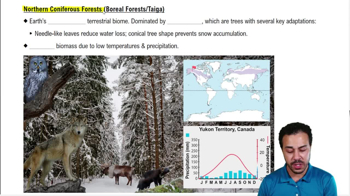
Northern Coniferous Forests (Boreal Forests/Taiga)
Island Biogeography Theory
The theory of island biogeography, proposed by Robert MacArthur and Edward O. Wilson, explains how the size and distance of an island (or habitat patch) affect species richness. Larger and closer habitats tend to support more species due to higher immigration rates and lower extinction rates. In the context of forest fragmentation, smaller patches may lead to reduced species diversity and increased dominance of certain species, potentially exacerbating the spread of Lyme disease.
Recommended video:
Guided course
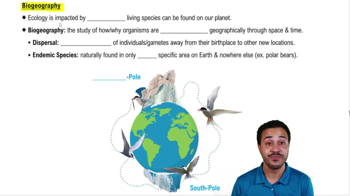
Biogeography
Related Videos
Related Practice








